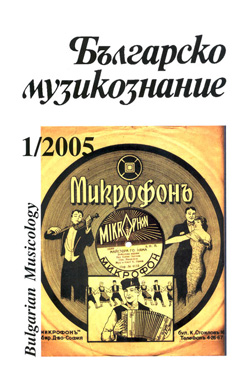Забравената пътека. Народни песни от Разложко, Драмско и Битолско от фонда на Ангел Букорещлиев и Серафим Боянов
The Forgotten Path. Folk Songs from the Regions of Razlog, Drama and Bitolia from the Fund of Angel Bukoreshtliev and Serafim Boianov
Author(s): Margarita PopovaSubject(s): Music
Published by: Институт за изследване на изкуствата, Българска академия на науките
Summary/Abstract: The work of Angel Bukoreshtliev, writing down in notes many Bulgarian folk songs, is the subject of two brief monographs and several articles by Ivan Kamburov, Elena Stoin, Todor Todorov, Agapia Balareva and Nikolai Kaufman. The main conclusion about the activities of Bukoreshtliev is that the conception of the first Bulgarian recorders is mature and contains ideas of the role of the song in Bulgarian folklore, of the importance of the musical component in the song, of the teams in the work of collecting and the regional studies of Bulgarian folk songs. The fact that the other archives in Sofia do not possess materials of Angel Bukoreshtliev and Serafim Boinaov increases the significance of their personal fund in the Music Folklore Archives of the Institute of Art Studies at the Bulgarian Academy of Sciences. The fund is stored in three files and contains 1425 copies of Bulgarian folk songs from several districts. A part of it contains songs from 8 villages in the region of Razlog, written down in notes in the last quarter of XIX century (the oldest notation dates from 1875). They were performed in one or two voices predominantly by women. They are systematized as ritual, labour, entertaining and songs without any special function, the majority being horo leading and sung at sedianka (a gathering of young people working together). It is valuable that the collectors immersed themselves in the live reality at that time. The notations of the melodies reflect Bukoreshtliev’s opinion about the metro-rhythmic peculiarities of our folk songs. The manifestations of the music rhythm (through measure and characteristic rhythmic groups) are analyzed as well as mode tonality (through sound sequence, intonation moves and cadences) and the two-voiced singing (through the role of each voice). The stable characteristics of the wedding songs in this region are pointed out. The harvesters’ melodies have specific notation typical for Bukoreshtliev. The songs from the village of Plevnia have no common features with those from Razlog whereas the songs from Bitolia differ from those of Razlog and Drama, and are a newer phenomenon. Most of the materials of Bukoreshtliev and Boianov have not been published, neither are there any scientific studies on them. The attitude to this archival fund raises a number of questions, without any replies so far.
Journal: Българско музикознание
- Issue Year: 2005
- Issue No: 1
- Page Range: 6-73
- Page Count: 68
- Language: Bulgarian
- Content File-PDF

